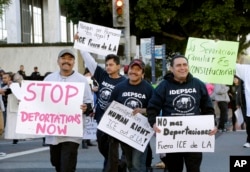President Donald Trump made clear in executive orders issued last week that he intends to strengthen enforcement of U.S. immigration laws — and that is likely to mean an increase in deportations.
How much of an increase remains unclear. President Barack Obama repatriated a record 2.5 million undocumented people between 2009 and 2015.
Trump said that subject to the availability of funds, he wants to hire 10,000 additional immigration officers and 5,000 new Border Patrol agents. That would be a significant boost for the Immigration and Customs Enforcement (ICE) workforce, which stands at about 20,000, while there are currently a little more than 21,000 Border Patrol agents. Those additional forces will most likely increase the number of apprehensions.
Punishing 'sanctuary cities'
Immigration officials identify undocumented immigrants in a number of ways: raiding workplaces suspected of hiring undocumented workers; tracing failed applications for asylum or green cards; acting on tips from citizens; and discovering undocumented status when people are arrested on other criminal charges.
ICE agents make arrests both on the basis of their own investigations and when they are contacted by state or local law enforcement who have made an arrest — sometimes for violations as minor as traffic stops — and suspect the person they are holding is undocumented.
This cooperation is a key way authorities find people who qualify for deportation, but law enforcement officials in some cities and counties have refused to work with federal authorities in rounding up undocumented immigrants. These places are known as sanctuary cities and counties.
In his executive order entitled “Enhancing Public Safety in the Interior of the United States,” Trump says he will cut off federal grant money to jurisdictions that do not cooperate with ICE in enforcing deportations. The city of San Francisco is already challenging the policy in court.
Trump has said he intends to target undocumented immigrants “with criminal records,” but in the executive order, he seems to reach beyond that. The order expresses an intent to go after not only those who have been charged with or convicted of criminal offenses but also people who may have committed a chargeable offense without charge or conviction. He also targets people who “have abused any program related to receipt of public benefits.”
Crowded detention centers
Jennifer D. Elzea, acting press secretary at the ICE's Office of Public Affairs, told VOA that ICE has a total of 203 detention facilities across the United States. Together, they contain a little more than 34,000 beds.
About 400,000 people are detained in these facilities every year, and the average stay is about 30 days. Some people stay much longer.
Using 2012 data, Syracuse University's TRAC, a data-gathering site that tracks the federal government's enforcement activities, found that 40 percent of the people detained in these facilities stay three days or less, while 3 percent can be there more than 180 days. TRAC says often the people who stay the longest are those who are in the U.S. legally and trying to prove their status.
In his order, Trump says he will build new detention facilities on the U.S.-Mexico border.
Court hearings
Immigration courts are notoriously clogged with a backlog of more than half a million cases. Immigrants awaiting their day in court face an average wait time of 678 days, or close to two years.
Trump is calling on the Department of Justice to provide immigration judges to immigration detention centers in his executive order titled “Border Security and Immigration Enforcement Improvements.”
Unlike American citizens, immigrants are not provided legal counsel and must hire their own lawyers or seek pro bono help from pro-immigration organizations. Having a lawyer can make a difference.
Deportees are unable to return to the U.S. for 10 years. Sometimes attorneys can negotiate for a voluntary removal, which requires offenders only to admit they have no legal right to remain in the U.S. and agree to depart on their own. People who have a case for staying are even more likely to need legal help.
Removal
In 2016, ICE conducted 240,255 removals, a 2 percent increase over the previous year. ICE says the increase was due to a combination of increased state and local cooperation and increased border interdictions.
Out of those, 65,332 removals were of individuals arrested inside the United States. The rest were apprehended at the borders or ports of entry.
Fifty-eight percent of all ICE removals, or 138,669, were people previously convicted of crimes, while 2,057 people removed by ICE were classified as suspected or confirmed gang members.
The leading countries of origin for removals were Mexico, Guatemala, Honduras and El Salvador, ICE reported.
Costs
The average cost of repatriating a person outside the United States — from identification, arrest, through removal — is $12,213, according to Elzea with ICE. “This cost includes all costs necessary to identify, apprehend, detain, process through immigration court, and remove an alien.”
At that rate, the cost of the Obama removals was $30.5 billion; the Trump directives indicate his administration will invest more, but how much is unclear.
It would take 20 years and cost the U.S. government $400 billion to $600 billion to remove all 11 million undocumented immigrants currently living in the United States and prevent all future unlawful entry, according to the conservative think tank American Action Forum (AAF).
Here is some of what AAF says would have to happen using fiscal 2013 data:
— Increase federal immigration apprehension personnel from 4,844 positions to 90,582.
— Increase immigration detention beds from 34,000 to 348,831.
— Increase immigration courts from 58 to 1,316.
— Charter a minimum of 17,296 flights and 30,701 bus trips each year.
































